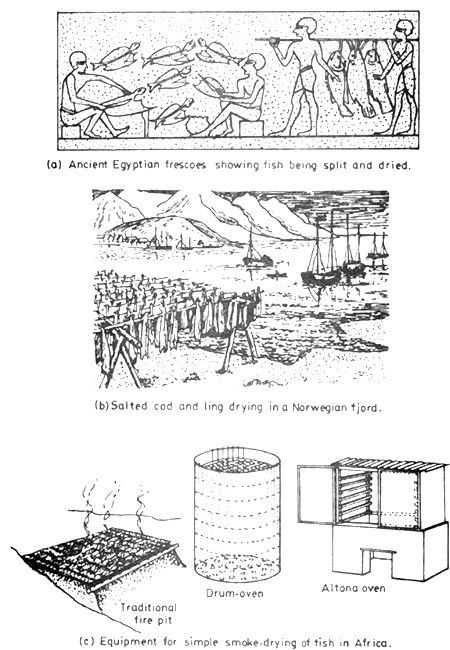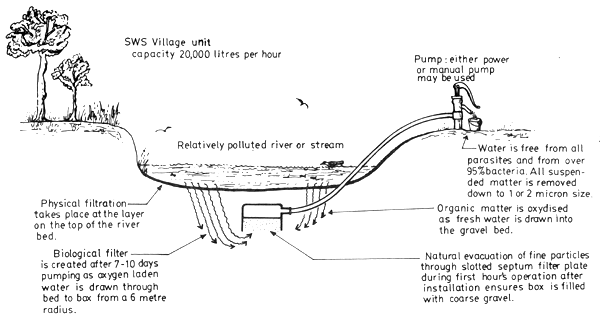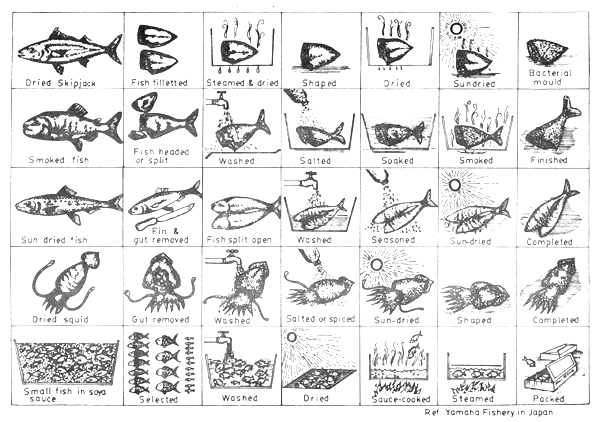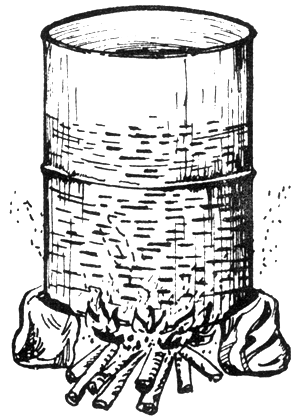The preservation of fish by canning began in the early part of the last century. By 1900 it was a well established industry. Freezing of fish by mechanical means is a more recent innovation, commercial applications of which began in this century and were greatly expanded after World War II. Before these mechanized and capital-intensive methods of preservation were developed, mankind preserved their food by traditional means, fish were dried, salted, pickled, smoked and fermented. In some countries the fish curing trade employed great numbers of people and their produce was a major national export1.
Fish can still be preserved today, in excellent quality, by traditional processes. Quality control is a problem quite distinct from that of processing technology. One can have bad quality fish produced by a freezing plant or cannery just as easily as by traditional fish curing establishments. Yet in most of our fishery development plans we seem to ignore traditional processes completely. There appears to be a fixation with capital-intensive technology. Some specialized outlets such as the shrimp export market certainly require expensive freezing and packing plants. But for the bulk of fish consumers in Asia, traditional cures are quite acceptable. They involve little capital expenditure and they are labour-intensive. Yet we have almost lost a wealth of historical experience in curing and only recently have paid any serious attention to the production of low-cost yet high quality cured fish. In our food technology laboratories and universities we have narrowed the field of academic studies in fish technology to “modern” capital-intensive processes which mostly serve the interests of only the richest consumers. (See Figure 18).
In attempting to upgrade traditional products we must start with primary fish handling to ensure that the initial quality of the fish is good. No amount of fancy processing can correct deterioration due to bad handling. Quality control at the pre-processing stage is going to involve us in at least three areas, namely:
Handling. Careful packing, use of ice or natural cooling. Installation of insulation materials in fish holds and fish cases.
Cleanliness. Washing of fish in clean water. Scrubbing of all on board fish areas and receptacles.
Speed. Prompt delivery of fish to market. Speedy landing and weighing. Minimum waste of time in selling and consigning.
1 Cutting, C.L. Fish Saving. London, L. Hill Books, Ltd., 1955.
Figure 18
DRYING FISH BY TRADITIONAL METHODS

ref. (a) & (b) Burgess et al, Fish Handling and Processing, HMSO London 1965
(c) Equipment and Methods for Improved Smoke-Drying in the Tropics
FAO FIIP/T 104 1971
None of these requirements are expensive or difficult to initiate. The technologies involved are simple. But together they would ensure prime quality fish for the retail markets and the processors.
Simple insulation of fish holds and fish boxes is possible using natural or synthetic materials. The main problem is that of making a watertight lining to keep the material dry. Simple wooden fish boxes could be used more but they must be scrubbed each trip after use. The introduction and use of stiff scrubbing brushes on all fishing boats and fish markets in Asia would do more for quality control than all the chemicals and instruments in the world.
Most fish markets have no adequate supply of clean water for fish washing. Now this can be obtained at low cost using SWS filtration units. This system which uses no chemicals and requires hardly any maintenance can supply clean water for ice plants or village drinking water supplies. The cost of a mechanized system is about $0.10 cents per liter per hour installed capacity. Manual systems using hand pumps would cost much less. Figure 19 illustrates how the system works1.
Speed in landing, selling and consigning fish is more an organizational than a technical problem. In far too many markets, fish lies for many hours in the warm air, waiting to be sold. Fishing boats equipped with capstans or simple winches could well use landing derricks as is done by most inshore boats in Europe. A well-trained crew can land a ton of fish in 6 minutes given a good swinging derrick and fast capstan. Even half this speed would be a great improvement for many Indo-Pacific vessels. Market sales should take place in the early morning unless other factors totally preclude this.
Fish quality could be greatly improved by keeping them in the same container from the vessel to the retail markets. The use of a simple fish box and proper washing and scrubbing of that box, would comprise a great improvement in most fisheries in the region. The leap to organized sale and distribution of fish in their original container and the safe and prompt return of that container, may be too much for all but the best organized cooperatives and enterprises. However, a recent Swedish system may be worth consideration.
In response to complaints by fishermen who were getting 1.50 kroner a kilogram for mackerel which sold for 12.0 kroner in the shops, Goran Larson of Fiskladan Packing AB collaborated with Government, Research and Industry in Sweden to reduce the costs of fish transport and marketing. They developed the Fish-On-Line system of transporting fresh fish. This is based on the use of a standard 30 kg. capacity plastic fish box. The box, called the “outerpack” is durable, with a life of many years. Before filling, each box has inserted a disposable “innerpack” of cardboard. After auctioning, each tier of boxes is placed on an “aquapack” pallet which catches ice water and slime, thus avoiding any contamination in container units. If open trucks or freight cars are used, a “spacepack” of fabric-backed aluminium foil is fitted over the tiers of boxes to maintain freshness and quality. A “combipack” liner which doubles as a display tray may be used when fish are destined for fishmongers shops. A “freezepack” container is used when the catch is destined for freezing plants. Fish may also be exported in their original containers.
1 Cansdale, G. Low Cost Water Filtration. FAO, Manila, SCS/79/WP/80, 1979.
Figure 19
ACTION OF SWS WATER FILTRATION SYSTEM
Suitable for gravel and sand bed rivers, streams and sea shores.
In unsuitable sites, artificial bed is used.

ref. Cansdale, G. Low cost water filtration, FAO SCSP/79/WP/80 Manila 1979
In additional to providing better quality fish more conveniently to the consumers it was estimated that the Fish-On-Line system could save Sweden annually, over 20 million kroner ($6.5 million) in fish box repairs and replacements plus over 25 million ($8.1 million) in freight charges, (1976)1.
Such a sophisticated scheme would not suit the low technology requirements of most of Asia's fisheries. But perhaps a simple container system using wooden boxes, thin plastic liners and plastic tarpaulin covers could be introduced on a limited scale to serve major fishing ports. Any merchants failing to return containers and liners would be charged for their replacement. Cleaning could be arranged in a cooperative box-washing pool using labour-intensive hygienic methods.
Given a good quality fish to work with, how can we improve on existing traditional processes? Most fish cured in rural villages is sun-dried. The spoilage rates are very high, particularly when the fish are laid on or close to the ground, and when they are not protected from dust, flies or rain showers. Solar fish driers could eliminate much of this spoilage. They would also speed up the process and give a better dried product. Their advantages are so numerous and their cost-benefits so obvious that one wonders why they were not introduced earlier.
A solar fish drier is a simple piece of equipment It is constructed of wood or bamboo and covered with plastic or glass2. In well-designed units, dark plastic is used underneath or black corrugated iron. Some air flow is needed to prevent condensation inside the unit. Flies are normally kept out by the heat alone, but fly screens may be used if available. Units cost about $10 per square meter and if one square meter dries 50 × 0.1 kgs fish each day, the saving on a 25% spoilage rate would be 1.2 kgs per day which would practically cover costs in 20 days at $0.50 per kg. (See Figure 20).
Solar ovens have been suggested for use in destroying pests or worms already in dried fish. This they can certainly do, but it would appear much more logical to dry properly in a solar unit in the first place thus eliminating the need for later treatment in an oven.
Figure 20
SOLAR FISH DRYER
Advantages

A combination solar/agro waste fish drier has been developed in the Philippines at the Santa Barbara Project, Cavite. This unit costing about $300 complete, will dry 80 kgs of fish in 8 hours. It consists of a sloping cabinet with side doors and 14 fish trays, all covered in heavy plastic. A heat booster is fitted at the front. This piece uses solar or agrowaste heat to warm up the drier and start convection. Only heat enters the unit. Smoke and fumes are excluded1.
Fermented fish products are relatively easy to make and can be produced by small cottage industry units. There are an abundance of such products in Asia, including fish sauces and fish relish. Fish crisps or kropek are also common and can be stored indefinitely in sealed plastic bags. Many of these products have considerable export potential.
Both smoked and dried fish could be improved and have their shelf life prolonged by judicious use of salt. The only constraints to this is the cost and availability of the salt. Many coastal villages in the tropics import their salt from places hundreds of miles away. It would appear to be a wise investment of time and effort for fisheries authorities to encourage the local production of salt from seawater. Minor technical improvements to salt pans, use of plastic shades in rain-susceptible regions, and more efficient apparatus for final boiling could all help improve production and reduce costs. (See Figure 21).
Considerable amounts of trash fish from the bottom trawl and purse seine fisheries in S.E. Asia are converted into fish meal for animal feed. Large fish meal plants are expensive and the production of fishmeal by small scale processors is rather inefficient and wasteful of heat energy. In any case, first priority should be given to salvaging as much as possible of the “waste” fish for human consumption. However, if there is little alternative to using the trash fish as animal feed, then it may be converted are relatively small cost into fish silage. This liquid product is made by the action of enzymes and acids. No special skills or expensive equipment is needed and the process does not create any unpleasant odours. These advantages over the fish meal process make it much more appropriate for small scale application. The liquid silage is heavier and more bulky to transport, but it can easily be sun-dried and thus put into solid form2.
Figure 21
TYPES OF DRIED, SALTED, SMOKED FISH FOR EXPORT MARKETS

One enormous potential benefit of fish silage is the possibility of utilizing all the trash fish on shrimp trawlers. If such vessels were made a few meters longer, and the additional space used for silage tanks, then each boat could land several tons of silage for each ton of shrimp caught. Government might well consider introducing a requirement that all trawlers over a certain size (say 50 tons) be fitted with silage tanks and land a minimum tonnage of silage for each ton of fish or shrimp. This would force big companies to reduce waste and at the same time would help reduce the country's fish meal imports. A state with a fleet of 200 shrimp trawlers of over 50 tons might thus produce over 10,000 tons of fish silage a year at very little additional cost. That would be worth over $1 million to the economy. Fish silage is currently produced on board Danish and other Scandinavian vessels in the North Sea1.
Much more use could be made of fish offal to produce oil. This can be done in remote villages with very limited facilities. Provided that the offal is fresh, the oil will be excellent for cooking. It will have a relatively short life, but then the stale oil could be used as a fuel. To extract oil from offal simply put it in a drum half-full of water. The offal volume should be no more than 50 per cent the water volume. The drum is placed over a fire and brought to the boil. After boiling for 20 minutes it is taken off the fire and the mixture allowed to settle. The oil will come to the surface from where it can be skimmed off. Fish oil is rich in vitamins A and D. The waste water may be fed to animals as it will contain many nutrients2.
Figure 22
| Extracting oil from fish offal (guts, livers, heads, bones, fins, tails, etc.) |  | Drum contains 50% water, 25% offal |
| Boil for at least 20 minutes then allow to settle |
2 Mortimer, M.A.E. et al. Fish Culture in Central East Africa. FAO, 1966.
Small rural fish curing units have the flexibility to engage in a variety of activities that larger plants may not be free to consider. They are therefore more suited to the production of alternative fish cures of relatively limited volume. These would include both edible and ornate fishery products. Some under-utilized species lend themselves well to the manufacture of fishery by-products. The beauty of a by-product industry is that it utilizes what would otherwise be waste material such as shells, cuttlefish bone, livers, offal and teeth. The shark is a remarkable example of a fish with a multitude of uses. From it can be made, fish steaks, oil, fish meal, jewelry, fin soup, and also very high quality leather1. The leather process requires skill if not machinery, but a fish curer or coop could begin by simply preparing the skins for sale to sharkskin leather tanning companies.
Figure 23 FISHERY BY-PRODUCTS : SHARK SKIN

1 Kreuzer, R. and Rashid, A. Shark Utilization and Marketing. FAO UNCTAD/ GATT, 1978.
The popularity of canned fish in rural areas cannot be disputed. But small canneries are notoriously bad risks economically. And the raw material for the cans is becoming increasingly expensive. In America alone, over 48,000,000,000 cans and 26,000,000,000 glass bottles are thrown away each year, after use1. Given present levels of pollution and the decline in finite and irreplaceable resources, such waste is surely iniquitous. Is there no substitute to the throw-away can? May we not replace it with a glass jar or bottle that can be recycled? Millions of bottles are recycled in Asia for the drinks industry. Surely we can do the same in fish preservation.
Technical problems involved in the use of recyclable glass containers for fish relate to the heat they must withstand in the retort, and the type of airtight lid or sealing to be used. Preserving fish in sealed glass jars requires slightly longer processing times than canning. A one pint (0.44 lit.) glass jar of Spanish mackerel must be cooked at 240°F for 100 minutes. The glass jars just also be allowed to cool more slowly. As they have to be cooked and sealed under pressure it is not normally considered feasible to do this as a cottage industry. But a sizeable cooperative might well operate a recyclable glass jar cannery2.
Small processing units utilizing glass jars have been proven to be viable in the Philippines. These use 4 pressure cookers of about 45 liters capacity which can each accommodate around 40 glass jars. The jars with fish are cooked at 240°C at 1.0 kg/cm2 pressure for 70 to 100 minutes (depending on jar size) to kill all spores that might create toxins. The pressure cookers may be heated on a gas stove or on a simple wood-burning stove. After pressure cooking, the lids are screwed tight and the closed jars inverted and allowed to cool. Good quality jars are needed for repeated use, and there is a need to develop better tops. These could be specially manufactured for use on fish jars. The Philippine experience indicates that the recyclable glass jar is a more economical proposition than the can despite current difficulties in obtaining jars and tops3.
1 Sullivan, P. World Environment Day. Sunday Times, London, 5 June 1978.
2 Bulletin 30-L. National Canners Association, Third Edition. USA.